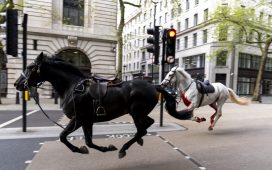There is no significant difference in the way humans and horses experience the pain of being struck by a whip, according to a landmark study that researchers say should end the argument on the continued use of the whip in horse racing.
It comes as Racing Victoria reaffirmed its commitment to reforming whip rules, after it formally tabled a proposal to phase out the whip at a board meeting of Racing Australia on Wednesday.
Racing Victoria said it would not discuss the meeting but that it maintained its belief that “the current national whip rules are no longer appropriate and that whip reform is vital for the future of our sport”.
“RV will continue to advocate for whip reform which we believe is essential if racing is to retain its existing audiences and to ensure that it’s attractive for the fans and employees of tomorrow,” it said in a statement. “Considerations around the use of the whip in Victorian racing will remain a key priority for RV in the weeks and months ahead.”
The chairman of Racing Australia, Greg Nichols, told Guardian Australia that board meetings were confidential but that the proposed changes to the whip rules were subject to “quite rigorous debate”.
“It’s an issue that generates a diversity of views, they were all expressed, and we are actioning the process [to review the number of penalties issued for breaching whip rules] that we set in train six months ago,” he said.
Nichols said he had requested a copy of the study on skin sensitivity and that it “could contribute to the debate as well”. “Everybody wants to be as informed as possible,” he said.
Racing NSW’s chief executive, Peter V’Landys, has previously criticised the proposed reforms, saying: “I would be the first to ban the whip if it did hurt the horse.”
“We should be calling it a riding crop,” he told Nine newspapers this month, saying Racing Victoria should instead focus on the number of deaths on the track at the Melbourne Cup. “Even the activists are starting to realise the whip doesn’t hurt the horse.”
The study, published in the journal Animals on Thursday and funded by RSPCA Australia, compared the skin structure and nerve supply in skin from 10 humans and 20 thoroughbred or thoroughbred-type horses.
The skin from the thoroughbreds was taken from the rumps of horses slaughtered at export abattoirs, and the human samples were supplied by Macquarie University’s anatomy laboratory.
The study found there was “no significant difference between the epidermal nerve counts of humans and horses”, meaning that humans and horses had a similar sensitivity to pain.
The dermis of the horse – the layer of tissue below the epidermis, or outer layer of skin – is significantly thicker than that of humans. But this research, led by veterinary pathologist Dr Lydia Tong of the Taronga Conservation Society, said that while that thicker dermis may offer some resilience against trauma, “it is not considered protective from external cutaneous pain”.
“These findings indicate that the superficial pain-sensitive epidermal layer of horse skin is as richly innervated and is of equivalent thickness as human skin, demonstrating that humans and horses have the equivalent key anatomic structures to detect cutaneous pain,” the study found.
It follows the publication of another study last month, also funded by the RSPCA, which found there was no benefit to race times or rider safety from using the whip.
The University of Sydney’s Prof Paul McGreevy said the study should end the argument that whipping does not hurt horses.
“I don’t think you will find a veterinarian who will say that racehorses don’t feel the whip or find it aversive.”
McGreevy said that while the whip was used in other equestrian disciplines, such as cross-country, which has faced its own reckoning on whip use, it is not generally used with the frequency and force seen in racing.
“There is an ethical degree of whip use that can get you out of trouble in a hazardous situation, but it is not the flogging that horses get on the racetrack,” he said. “It’s an irritant and proportionate to need.”
The whip was recognised as an aversive aid in horse riding and training – an aid that works because the animal wants to get away from it. The bit, spurs and kicking with a rider’s heels are also aversive aids.
The International Society for Equitation Science has said that where aversive aids are used, “a minimum amount and period of pressure should be applied to achieve the required response”.
Australia’s racing rules allow the whip to be used no more than five times before the final 100 metres of the race, when it can be used at the rider’s discretion. The jockey who rode second placed Tiger Moth in last week’s Melbourne Cup, Kerrin McEvoy, was fined $50,000 for breaching the whip rules.
McGreevy said jockeys could feel obliged to use the whip so that punters felt they had seen the horse run its best possible race.
“Whip use is established in racing because jockeys are required to show that they are riding the horse out on its merits,” he said. “That level of whip use is not expected in other disciplines and is not on the same scale.”
Racing NSW did not respond to requests for comment.








